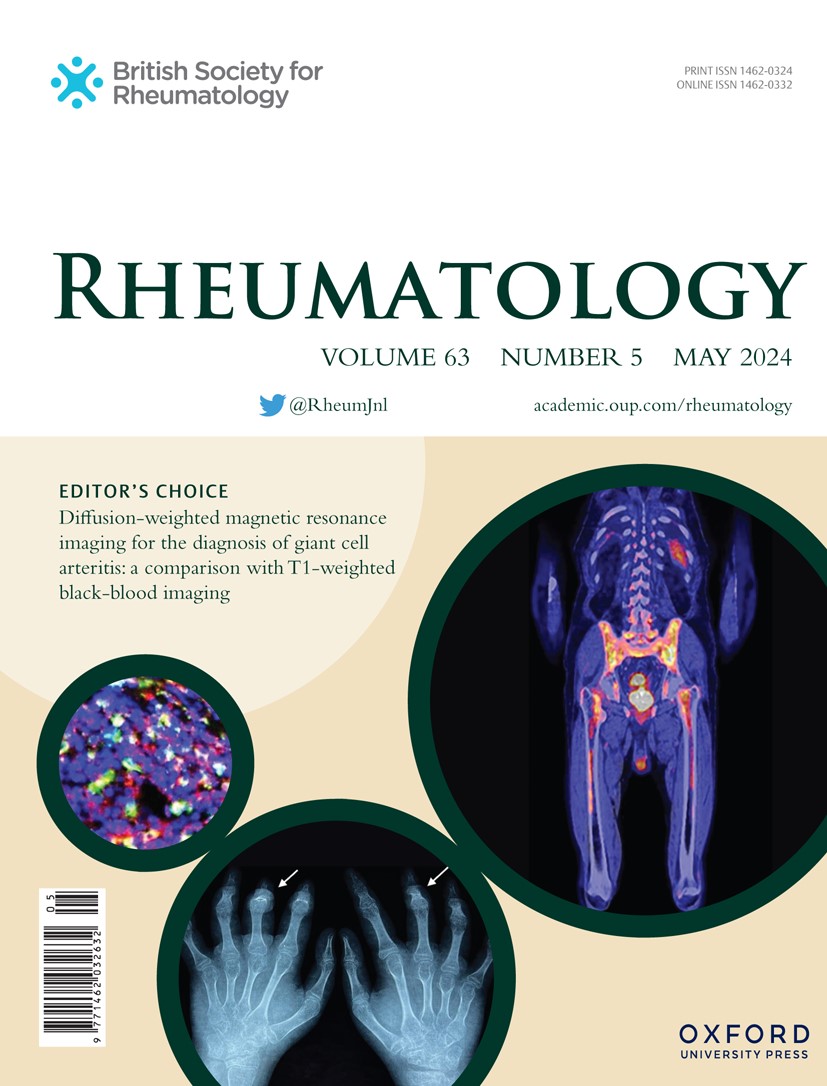接受secukinumab治疗2年的银屑病关节炎患者的影像学进展状态与低疾病活动度的关系
IF 4.4
2区 医学
Q1 RHEUMATOLOGY
引用次数: 0
摘要
目的探讨接受secukinumab治疗的银屑病关节炎(PsA)患者放射学进展与第104周低疾病活动性(LDA)或缓解之间的关系。方法:该事后分析纳入了FUTURE 5 iii期研究(NCT02404350)中活动性PsA患者的数据。患者根据第104周接受的治疗(secukinumab 300 mg带负荷剂量[LD], secukinumab 150 mg带LD,或secukinumab 150 mg无LD)进行分组,并根据放射学进展状态进行分组。放射学进展定义为从基线到第104周的变化,van der Heijde修正总夏普评分为0.5。通过最小疾病活动性(MDA)、极低疾病活动性(VLDA)和银屑病关节炎疾病活动性指数(DAPSA) LDA或缓解来评估疗效。通过logistic回归分析确定与第104周放射学进展相关的人口统计学和临床特征。结果纳入本分析的541例患者中,457例(84.5%)为放射学无进展,84例(15.5%)为放射学进展。与进展者相比,未进展者在第104周达到MDA、VLDA和DAPSA LDA和缓解的比例更高。第104周放射学进展与年龄较大和基线高敏c反应蛋白水平升高相关,而未进展与300 mg secukinumab (vs 150 mg无LD的secukinumab)、先前未暴露于肿瘤坏死因子抑制剂和较低的体重指数相关。结论:通过2年的secukinumab治疗,无放射学进展的患者在第104周的LDA状态比放射学进展的患者有更高的成就。临床试验注册ClinicalTrials.gov;NCT02404350本文章由计算机程序翻译,如有差异,请以英文原文为准。
Relationship of radiographic progression status to low disease activity in patients with psoriatic arthritis receiving secukinumab treatment for two years
Objective To examine relationships between radiographic progression and achievement of low disease activity (LDA) or remission at week 104 in patients with psoriatic arthritis (PsA) receiving secukinumab. Methods This post hoc analysis included data from patients with active PsA enrolled in the phase 3 FUTURE 5 study (NCT02404350). Patients were pooled by treatment received at week 104 (secukinumab 300 mg with loading dose [LD], secukinumab 150 mg with LD, or secukinumab 150 mg without LD) and grouped by radiographic progression status. Radiographic progression was defined as change from baseline to week 104 in van der Heijde modified Total Sharp Score >0.5. Efficacy was assessed by achievement of minimal disease activity (MDA), very low disease activity (VLDA), and Disease Activity Index for Psoriatic Arthritis (DAPSA) LDA or remission. Demographics and clinical characteristics associated with radiographic progression at week 104 were identified by logistic regression analyses. Results Of the 541 patients included in this analysis, 457 (84.5%) were radiographic nonprogressors and 84 (15.5%) were radiographic progressors. Higher proportions of nonprogressors achieved MDA, VLDA, and DAPSA LDA and remission at week 104 than progressors. Radiographic progression at week 104 was associated with older age and higher baseline high-sensitivity C-reactive protein level, whereas nonprogression was associated with 300 mg secukinumab (vs 150 mg secukinumab without LD), no prior exposure to tumour necrosis factor inhibitors, and lower body mass index. Conclusion Patients without radiographic progression through 2 years of secukinumab treatment had greater achievement of LDA states at week 104 than patients with radiographic progression. Trial registration ClinicalTrials.gov; NCT02404350
求助全文
通过发布文献求助,成功后即可免费获取论文全文。
去求助
来源期刊

Rheumatology
医学-风湿病学
CiteScore
9.40
自引率
7.30%
发文量
1091
审稿时长
2 months
期刊介绍:
Rheumatology strives to support research and discovery by publishing the highest quality original scientific papers with a focus on basic, clinical and translational research. The journal’s subject areas cover a wide range of paediatric and adult rheumatological conditions from an international perspective. It is an official journal of the British Society for Rheumatology, published by Oxford University Press.
Rheumatology publishes original articles, reviews, editorials, guidelines, concise reports, meta-analyses, original case reports, clinical vignettes, letters and matters arising from published material. The journal takes pride in serving the global rheumatology community, with a focus on high societal impact in the form of podcasts, videos and extended social media presence, and utilizing metrics such as Altmetric. Keep up to date by following the journal on Twitter @RheumJnl.
 求助内容:
求助内容: 应助结果提醒方式:
应助结果提醒方式:


